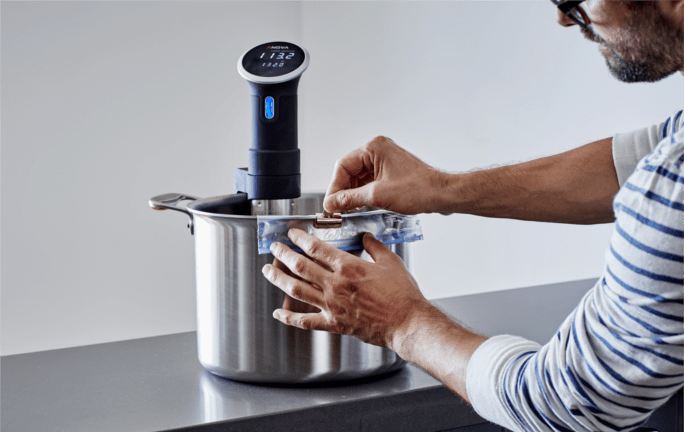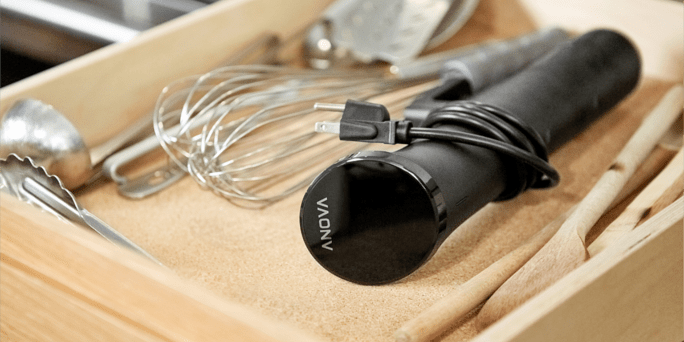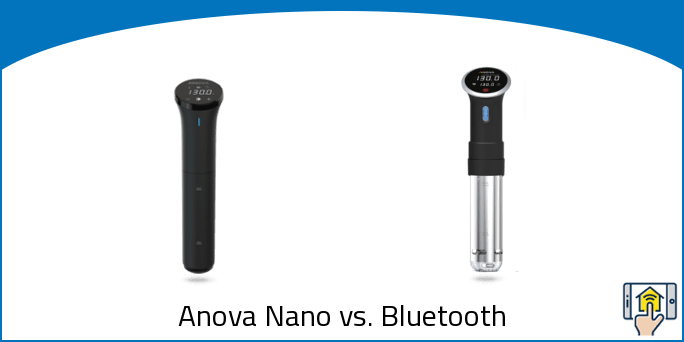Sous Vide offers an excellent way to evenly cook food, and like many other types of electronics, the advent of smart technology has shown us the incredible capabilities that these coolers have to offer. When comparing the Anova Nano vs. Bluetooth, it’s clear that both options have their benefits and drawbacks. We feel the Nano is the better option for the average home cook, although the Bluetooth model is a little sturdier has its own perks as well.
When deciding between the Nano and the Bluetooth models, you’re essentially making some choices between easier accessibility and affordability and more cooking power. The Nano does a great job with hands-free operation and a less expensive price tag, while the Bluetooth model is sturdier and offers better heating.
Below, we dive deep into the details of these two sous vide cookers. Read on for the full picture, or use the navigation bar to jump right to the comparisons that interest you most.
Anova Nano vs. Bluetooth — Things in Common
-
App Control – Both models have the same Anova app control that makes cooking, controlling settings, and keeping track of your recipes a breeze — right from your mobile device.
Speaking of recipes, Anova offers the world’s most impressive collection of sous vide recipes — completely free of charge within the app. You can choose between recipes for every skill level, and enjoy simple directions to cook any meal with ease.
The Anova app allows you to start the cooking process and monitor the food from wherever you happen to be, leaving you less tied to the kitchen and free to go about your day as the sous vide handles the preparation completely.
Other features include guided cooking to get the perfect doneness every time, notifications on your cooking status, the ability to share and favorite recipes, and a collection of “Serious Eats” sous vide guides.
-
No other equipment needed – One of the best aspects of these cookers is that you need no extra equipment for cooking. Simply place the food in the resealable bag and clip it to the side of the pot, allowing the sous vide process to cook your food exactly to your preferences.
-
0.1° Accuracy – Temperature can make all the difference with cooking, and doubly so with a process like sous vide. Luckily both models can maintain a set temperature with an amazing 0.1-degree accuracy.
-
Delicious Results – The sous vide process is a cooking technique that uses precision temperature control for perfect cooking results without any complicated monitoring. The Anova machines, like any sous vide cookers, circulate heated water in a pot to cook food to the exact temperature provided.
The technique is simple to understand and utilize, and sous vide is now easier than ever before to bring into your home for perfection every time you cook!
Anova Nano vs. Bluetooth — Differences

-
Difference #1: Heating Power & Pump – The first difference when comparing the Anova Nano vs. Bluetooth is the heating power and pump that they utilize.
The Anova Nano uses a 750W heating source with an1.25 GPM 4.6 LPM pump for circulating the water. It’s a great option for the average home chef that ensures an affordable and effective cook. The downside to the lower power means that it will take a little longer for the water to heat up, which means you won’t reach doneness quite as quickly.
The Anova Bluetooth, on the other hand, takes things a step further with a more powerful 800W heating source and 2.1-2.4 GPM 7-8 LPM. If you’re looking for a sturdier and more professional sous vide cooker, this might be more up your alley.
-
Difference #2: Max & Min Temperature – Unsurprisingly, the more powerful heating source on the Anova Bluetooth means you’ll be able to reach greater maximum temperatures, however, the Anova Nano can reach significantly lower temperatures as well, which gives it a wider range overall.
The Anova Nano can reach a maximum temperature of 197°F / 92°C and a minimum of 32°F / 0°C, while the Anova Bluetooth has a maximum of 210°F / 99°C and a minimum of 77°F / 25°C.
-
Difference #3: Connectivity – There are also some differences between the two models in the way that they connect. Neither device uses WiFi, and both use Bluetooth, although the Nano uses BLE 4.2 while the Bluetooth model uses BLE 4.0.
Bluetooth 4.2 is the newest Bluetooth technology and is also backwards compatible with 4.0 and 4.1 technology as well. 4.2 is more power efficient and offers highly secure features that allow only trusted owners to track the device location and pair devices.
Additionally, this newest Bluetooth tech enables 250% faster and more reliable data transmission as well as 10x more packer capacity.
Ultimately, although the Anova Bluetooth has the word “Bluetooth” in its name, the Nano actually does a better job on the connectivity front.
If you’re looking for a sous vide option that uses WiFi, check out the Anova WiFi + Bluetooth and our comparison of Anova Bluetooth vs. WiFi.
-
Difference #4: Size – In terms of size, the Anova Nano is slightly smaller than the Anova Bluetooth at a height of 12.8 in / 35 cm vs. 14.75 / 36.8 cm. The smaller size of the Nano makes it perfectly suited for fitting into your utensil drawer right along other tools like whisks and ladies, which leaves your counters less cluttered and your new cooking tool within easy reach.
While the Nano is definitely noticeably smaller than the Bluetooth model, the difference is rather minor in the grand scheme of things. You shouldn’t really have trouble fitting the Bluetooth model in the average-sized drawer, despite it being slightly taller.
-
Difference #5: Clamp – One notable drawback with the Anova Nano is the clamp. It has a max opening of 0.7 in / 1.8 cm and weighs 1.6 pounds / 0.7 kg, but the real problem is that it is not adjustable. This means that you’ll need to use a larger pot in order to correctly use the sous vide, which can be a tremendous waste of water. This lack of flexibility is one area in which the newer model took a significant step backwards.
The Anova Bluetooth is easily adjustable and has a max opening of 1.25 in / 3.175 cm with a weight of 2.6 pounds / 1.1 kg.
-
Difference #6: Material – The Anova Nano is made out of plastic, while the Anova Bluetooth is made out of metal for the lower part that goes into the water and plastic for the upper body.
Overall, the Anova Bluetooth is more solid and has a better construction. It also looks more sleek and professional when compared to the plastic on the Nano. With that said, the Bluetooth’s plastic construction still gets the job done, and by avoiding metal the company was able to significantly cut costs.
-
Difference #7: Display – Both models, like the previous Anova models and unlike the Joule, feature an LED Display.
The touchscreen on the wand itself ensures you’ll have access to controls and recipes without having to constantly pick up your phones with your grubby hands. The app is a little bit easier to use for finding the recipes in all honesty, but for everything else, the display is a great option.
The main difference between the Nano and Bluetooth models, in this case, is that the Nano is controlled with a scroll wheel while the Bluetooth has a touchscreen.
-
Difference #8: Speaker – One of the benefits to the sous vide cooking style is the ability to set it and forget it. The Nano makes that easier with a speaker that will chime when your food is ready. It will also make a nice sound when you touch the display panel.
The Bluetooth version has no speaker and thus doesn’t produce any sounds. You’ll still be notified through the app, however, so it’s not the end of the world.
Anova Nano vs. Bluetooth — Comparison Chart
| Anova Nano | Anova Bluetooth | |
|---|---|---|
| Pump | 1.25 GPM 4.7 LPM | 2.1 – 2.4 GPM 7-8 LPM |
| Maximum Temperature | 197°F / 92°C | 210°F / 99°C |
| Minimum Temperature | 32°F / 0°C | 77°F / 25°C |
| Heating Power | 750W | 800W |
| Preheat Time from 75F to 135F | 30 minutes | 24 minutes |
| Power input | 110-120VAC | 110-120VAC (220-240V EU) |
| Connectivity | BLE 4.2 | BLE 4.0 |
| Length | 2.2 in / 5.6 cm | 2.75 in / 6.98 cm |
| Width | 2.2 in / 5.6 cm | 2.75 in / 6.98 cm |
| Height | 12.8 in / 32.5 cm | 14.75 in / 36.8 cm |
| Immersion Depth | 7.25 in / 18.4 cm | 7.25 in / 18.4 cm |
| Max Clamp Opening | 0.7 in / 1.8 cm | 1.25 in / 3.2 cm |
| Minimum Immersion Depth | 2.44 in / 6.2 cm | 2.5 in / 6.35 cm |
| Weight | 1.6 lbs / 0.7 kg | 2.5 lbs / 1.1 kg |
| 360° Directional Pump | Yes | Yes |
| Material | Plastic | Metal, plastic |
| Adjustable Height Clamp | No | Yes |
| Speaker | Yes | No |
| LED Display | Yes | Yes |
| Touch Screen | Yes | No |
| LED Backlit Scroll Wheel | No | Yes |
| Set Timer for up to 99 Hours | Yes | Yes |
| Can Serve | 6–7 people | 7–8 people |
Anova Nano vs. Bluetooth — Accessories

All you really need to get started with sous vide are the wands itself, but you can enhance the process with some additional accessories.
For the Anova Nano, we recommend a Hard Case for storage as well as a food storage container for keeping ingredients. Both models will also benefit from this combination , or this stand-alone Vacuum Sealer.
Anova Nano vs. Bluetooth — Our Thoughts

When comparing the Anova Nano vs. Anova Bluetooth, it’s difficult to declare a clear winner.
We’re big fans of the Nano due to its affordability, easy on-screen controls, and flexible temperature range. It’s a solid option for home cooks that won’t break the bank.
On the other hand, the Anova Bluetooth is more solid with its adjustable clamp for greater flexibility and better heating capabilities with a bi-metal rise and a stronger wattage.
If we had to pick a model to recommend, we’d probably lean towards the Nano since it’s more attractively priced and a little bit easier to use for the home kick. The Anova Bluetooth still remains an extremely competitive option, however, despite being a more dated model.
Last update on 2024-04-19 at 21:10 / Affiliate links / Images from Amazon Product Advertising API



